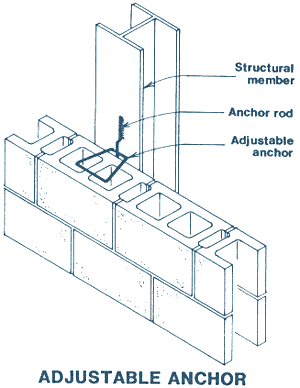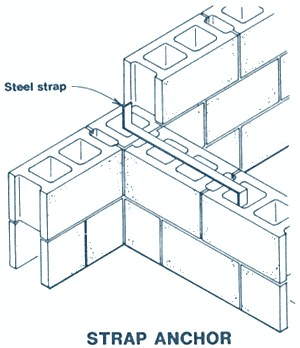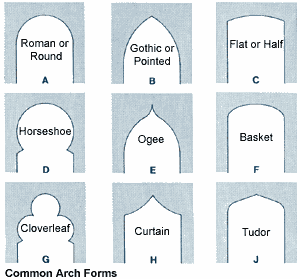
A B C D E F G H I J K L M N O P Q R S T U V W X Y Z
|
A
|
ABACUS. The uppermost member of the capital of a column; often a
plain square slab.
ABATE. In stone carving or sand blasting clay masonry, to cut
away material, leaving parts in relief.
ABSORPTION. The weight of water a brick unit absorbs, when immersed
in water for a stated length of time, expressed as a percentage of the
weight of the dry unit. See ASTM Specification C 67.
ABUTMENT. The supporting wall or pier that receives the thrust
of an arch.
ACCELERATOR. In masonry, any ingredient added to mortar to speed
drying and solidifying. (Compare retarding agent.)
ACI. American Concrete Institute.
ACTUAL DIMENSION. Exact size of masonry unit (see nominal dimension.)
ADHERED VENEER. Veneer secured and supported through adhesion
to bonding material applied over backing. (UBC)
ADMIXTURES. Materials added to mortar to impart special properties
to the mortar.
AGGREGATE. Inert material that is mixed with cement, lime and
water to produce grout or mortar.
AIR DRYING. The process of drying block or brick without any
special equipment, by exposure to ambient air.
AISC. American Institute of Steel Construction.
ANCHOR. A piece or assemblage, usually metal, used to attach
building parts (e.g., plates, joists, trusses, etc.) to masonry or masonry
materials.
Adjustable Anchor. Anchor which is vertically and/or horizontally
adjustable.


ANCHORED VENEER. Veneer secured to and supported by approved
mechanical fasteners attached to backing. (UBC)
ANGLE CLOSER. A portion of a whole brick that is used to close
the bond of brickwork at corners.
ANSI. American National Standards Institute.
ARCADE. From latin arcus, an arch. A row of arches on pillars
or columns; a colonnade.
ARCH. (1) A form of construction in which a number of units span
an opening by transferring vertical loads laterally to adjacent units
and thus to the supports. As arch is normally classified by the curve
of its intrados. (2) Curved compressive structural member spanning openings
or recesses; also built flat.
Abutment. The skewback of an arch and the masonry that supports
it.
Arch Axis. The median line of the arch ring.
Back Arch. A concealed arch carrying the back of a wall where
the exterior facing is carried by a lintel.
Camber. The relatively small rise of a jack arch.
Constant-Cross-Section Arch. An arch whose depth and thickness
remain constant throughout the span.
Crown. The apex of the arch ring. In symmetrical arches, the
crown is at mid-span.
Depth. The depth of any arch is the dimension that is perpendicular
to the tangent of the axis. The depth of a jack arch is taken to be
its greater vertical dimension,
Extrados. The exterior curve that bounds the upper extremities
of the arch.
Fixed Arch. An arch whose skewback is fixed in position and inclination.
Plain masonry arches are, by nature of their construction, fixed arches.
Gothic or Pointed Arch. An arch, with relatively high rise, whose
sides consist of arcs or circles, the centers of which are at the level
of the spring line. The Gothic arch is often referred to as a drop,
equilateral, or lacent arch, depending on whether the spacings of the
center are respectively less than, equal to, or more than the clear
span.
lntrados. The interior curve that bounds the lower extremities
of the arch (see Soffit.) The distinction between soffit and
intrados is that the intrados is linear, whereas the soffit is a surface.
Jack Arch. A flat arch.
Major Arch. Arch with span greater than 6 ft. and having equivalent
uniform loads greater than 1000 lb/ft. Typically, a Tudor arch, semicircular
arch, Gothic arch, or parabolic arch. Rise-to-span ratio greater than
0.15.
Minor Arch. Arch with maximum span of 6 ft. and loads not exceeding
1000 lb/ft. Typically, a jack arch, segmental arch, or multicentered
arch. Rise-to-span ratio less than or equal to 0.15.
Multicentered Arch. An arch whose curve consists of several arcs
of circles which are normally tangent at their intersections.
Relieving Arch. One built over a lintel, flat arch, or smaller arch
to divert loads, thus relieving the lower member from excessive loading.
Also known as discharging or safety arch.
Rise. The rise of a minor arch is the maximum height of arch
soffit above the level of its spring line. The rise of a major parabolic
arch is the maximum height of arch axis above its spring line.
Segmental Arch. An arch whose curve is circular but less than a
semicircle.
Semicircular Arch. An arch whose curve is a semicircle (Roman
Arch).
Skewback. The inclined surface on which the arch joins the supporting
wall. For jack arches the skewback is indicated by a horizontal dimension.
Soffit. The undersurface of the arch.
Span. The horizontal distance between abutments. For minor arch
calculations the clear span of the opening is used. For a major parabolic
arch the span is the distance between the ends of the arch axis at the
skewback.
Spring Line. For minor arches the line where the skewback cuts
the soffit. For major parabolic arches, the term commonly refers to
the intersection of the arch axis with the skewback.
Trimmer Arch. An arch (usually a low-rise arch of brick) used
for supporting a fireplace hearth.
Tudor Arch. A pointed four-centered arch of medium rise-to-span
ratio.
Voussoir. One of the wedge-shaped masonry units which forms an arch
ring.

ARCHITRAVE. Lowermost unit of an entablature, carried by columns
(or their capitals) or pilasters. Beam over columns (also epistyle).
ARGILLITE. Metamorphic rock resulting from the hardening of siltstone
and/or claystone and shale.
ARKOSE. Sandstone containing feldspar grains in abundance.
ARRIS. External angular intersection between two planar faces,
or two curved faces (as in moldings), or between two flutes on a Doric
column, or between a flute and the fillet on an Ionic or a Corinthian
column.
ARTIFICIAL STONE. A contradiction in terms, as stone is a naturally
occuring earth material. This phrase is used to describe materials variously
called art marble, artificial marble, cast stone, terazzo, patent stone,
and reconstructed stone. A mixture of stone chips or fragments embedded
in a matrix of cement or plaster with the surface ground, polished,
molded, or otherwise treated to simulate stone.
ASHLAR MASONRY. Masonry composed of rectangular units of burned
clay or shale, or stone, generally larger in size than brick and properly
bonded, having sawed, dressed or squared beds, and joints laid in mortar.
Often the unit size varies to provide a random pattern, random ashlar.
ASHRAE. American Society of Heating, Refrigerating, and Air-Conditioning
Engineers.
ASTM. American Society for Testing and Materials.
AZULEJOS. Spanish azul blue wall tiles of burnt clay with colored
glazed patterns.
Back to WSCMC Home
Masonry Institute of Washington
This site created
by Paragraphics
© 1998 - 2000 Paragraphics
all rights reserved